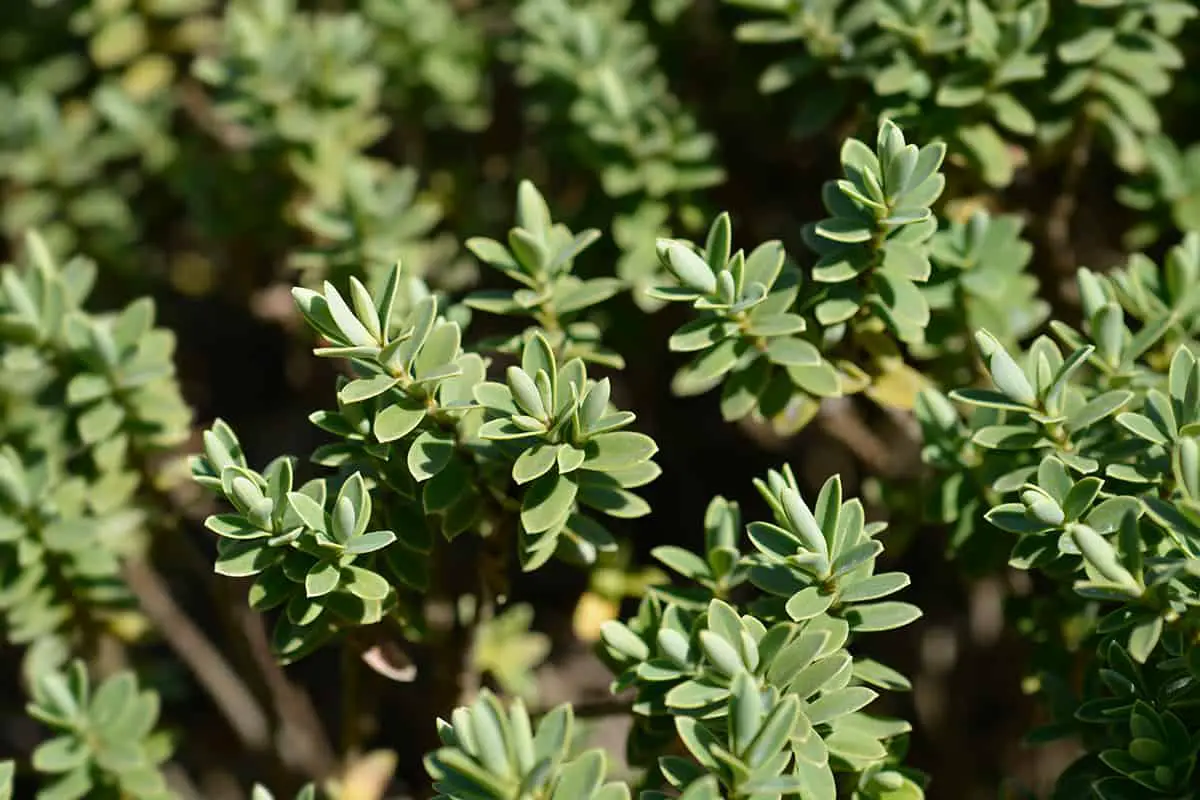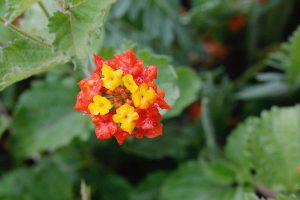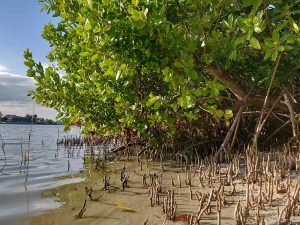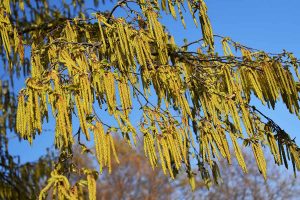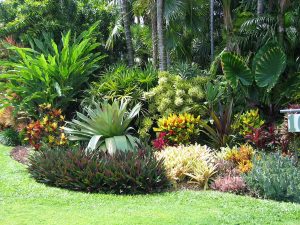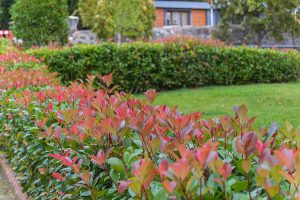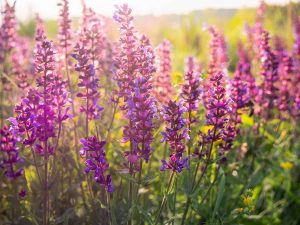Dwarf shrubs are great for filling gaps between taller shrubs and trees, however, these will typically be in a position of partial shade from the overhead canopy.
Dwarf shrubs that thrive in full sun work really well as stand-alone plants, and their size means they are an excellent option for planting in containers. Dwarf shrubs can also be planted in rows to form low borders or hedges. Here we look at some of the best dwarf shrubs available that prefer full sun.
Table of Contents
- Balsam Fir ‘Nana’
- Flowering Maple ‘Lucky Lantern Yellow’
- Japanese Maple ‘Wilson’s Pink Dwarf’
- Japanese Barberry ‘Fireball’
- Boxwood ‘Blauer Heinz’
- Heather
- Lawson Cypress ‘Minima Glauca’
- Dwarf Fothergilla
- Shrubby Veronica
- Hydrangea ‘Fire Light Tidbit’
- Common Juniper ‘Compressa’
- Creeping Juniper
- Arborvitae ‘Danica’
- Dwarf Mountain Pine ‘Ophir’
- Norway Spruce ‘Little Gem’
Balsam Fir ‘Nana’
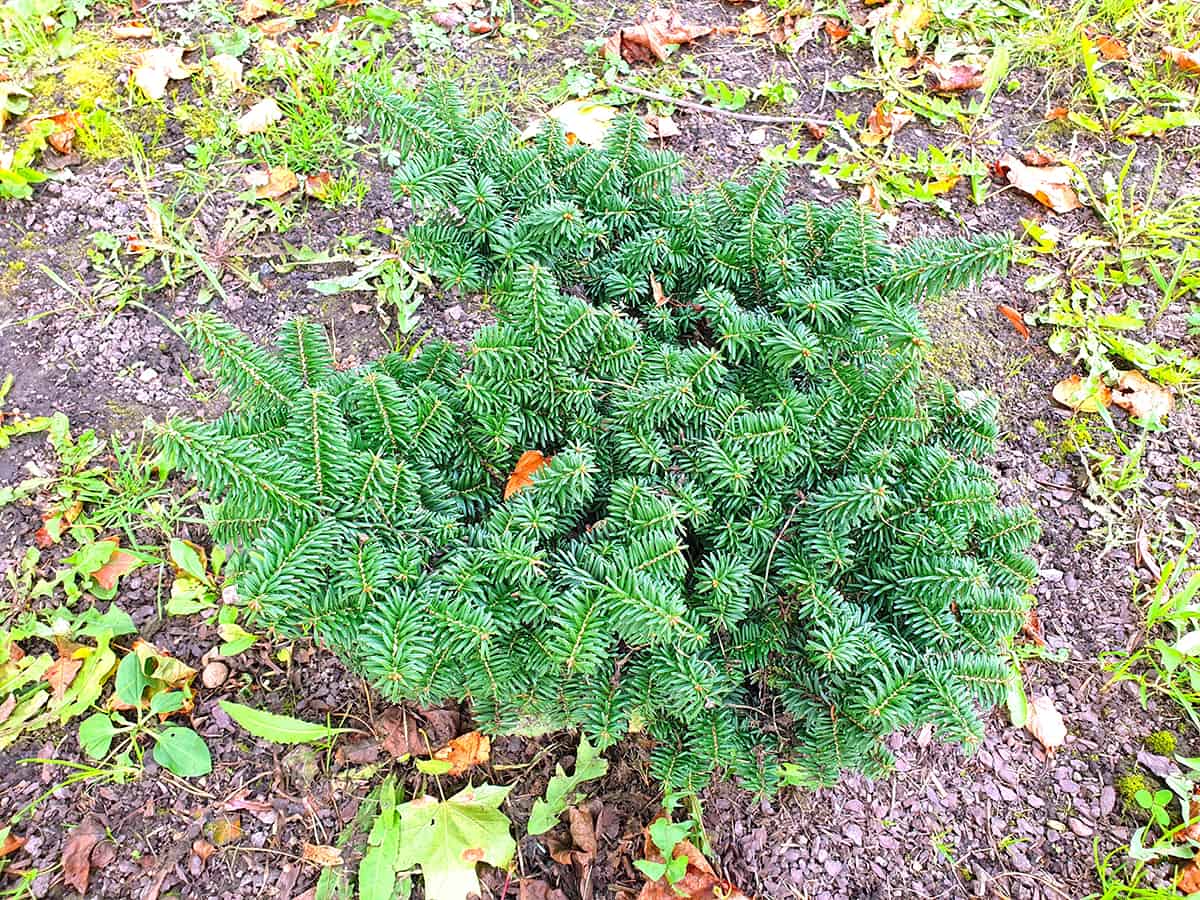
- Botanical name: Abies balsamea ‘Nana’
- Plant family: Pinaceae
- USDA hardiness zone: 3- 6
- Mature height: 1 to 2 feet
- Mature spread: 1 to 2 feet
This is a dwarf evergreen conifer that has a mound-forming habit. It provides a dense, lush green carpet of foliage all year round, which produces an appealing aroma. It is ideal for use in containers or in a rock garden and should be grown in full sun, in well-draining soil. Aim to keep the soil moist but not wet, and avoid climates that are humid.
Flowering Maple ‘Lucky Lantern Yellow’
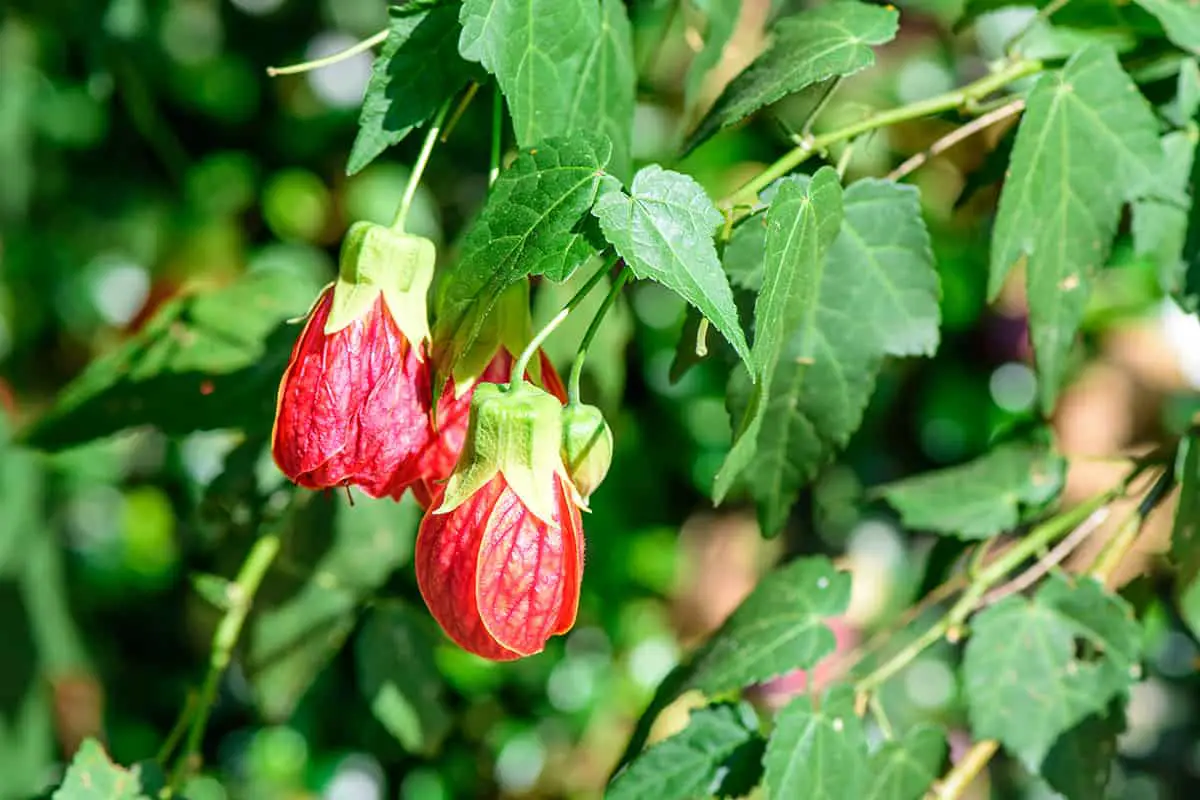
- Botanical name: Abutilon ‘Lucky Lantern Yellow’
- Plant family: Malvaceae
- USDA hardiness zone: 8- 10
- Mature height: Up to 1 foot
- Mature spread: Up to 1 foot
Despite their common name, these dwarf shrubs are not related to the Acer/Maple family. They are semi-evergreen, depending on the climate. They enjoy full sun and high levels of heat, along with moist and rich well-draining soil.
These plants will bloom all year round with lemon yellow flowers in some climates, and in cooler regions will bloom throughout summer until the first frost.
Japanese Maple ‘Wilson’s Pink Dwarf’
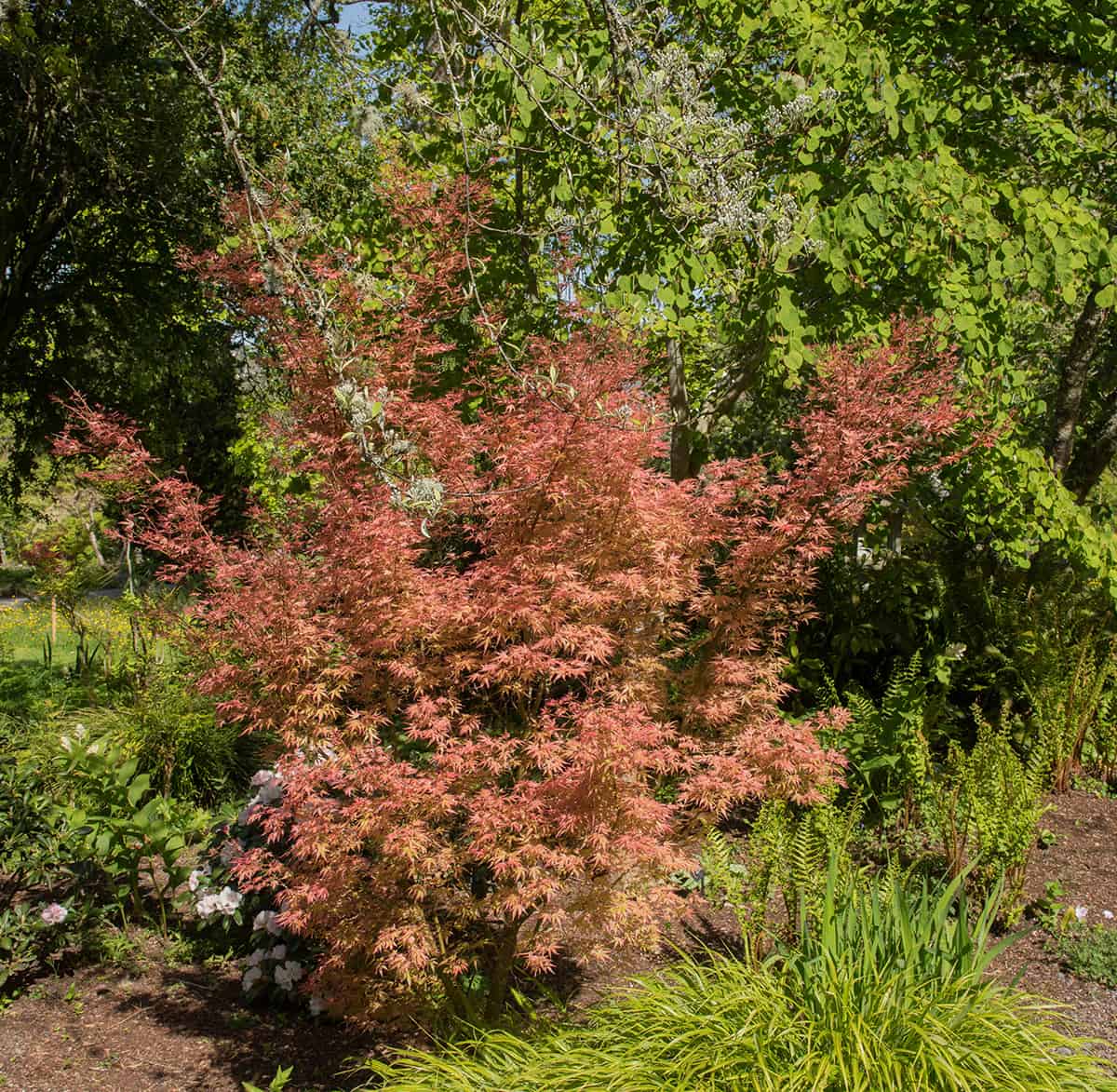
- Botanical name: Acer palmatum ‘Wilson’s Pink Dwarf’
- Plant family: Sapindaceae
- USDA hardiness zone: 6- 9
- Mature height: 2 to 4 feet
- Mature spread: 4 to 6 feet
This is a dwarf version of the popular Japanese Maple, taking the form of a deciduous compact shrub. This plant is loved for its vibrantly colored foliage, which changes throughout the season. It emerges in a coral pink shade before turning to bright orange.
By summer, the leaves will have developed to a striking shade of lime green before reverting back to a faded coral, continuing on to bright red before shedding from the plant. This dwarf maple has dense foliage and is ideal for container growing or low borders. It thrives in full sun and will benefit from a top layer of mulch to keep roots cool.
Japanese Barberry ‘Fireball’
- Botanical name: Berberis thunbergii ‘Fireball’
- Plant family: Berberidaceae
- USDA hardiness zone: 4- 8
- Mature height: 1 to 2 feet
- Mature spread: 1 to 2 feet
This is a dwarf shrub with exceptionally showy foliage. It has a dense, compact growth habit, and is deciduous. It has vibrant red-purple leaves which maintain their color throughout summer until fall when they drop from the plant.
It is a great choice for adding color to the garden without using flowers and produces the most vibrant foliage color when grown in full sun. It thrives in medium to dry soils that are well-draining. Plant it in rows to create an informal low hedge, or in container pots on a patio.
Boxwood ‘Blauer Heinz’
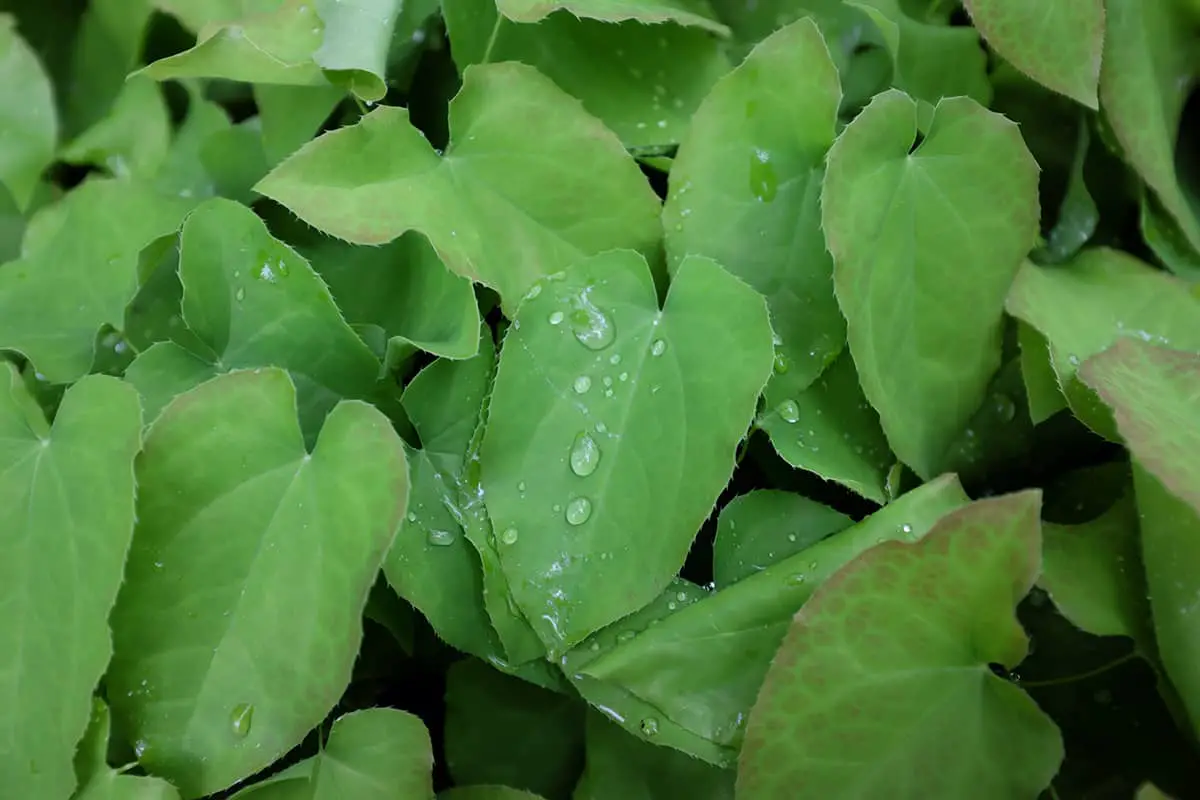
- Botanical name: Buxus ‘Blauer Heinz’
- Plant family: Buxaceae
- USDA hardiness zone: 5- 9
- Mature height: 1 to 2 feet
- Mature spread: 1 to 2 feet
This compact shrub is an evergreen that produces glossy leaves all year round. It has a dense, rounded habit, forming attractive mounds of lush blue-green foliage. This is a sturdy plant that grows easily, and if kept in full sun will need to be grown in consistently moist soil.
It is a perfect plant for patios and growing in containers. Boxwood is only drought tolerant when grown in partial shade, and you should aim to avoid letting the soil dry out for the best growth.
Heather

- Botanical name: Calluna vulgaris
- Plant family: Ericaceae
- USDA hardiness zone: 4- 6
- Mature height: 1 to 2 feet
- Mature spread: 1 to 2 feet
Heathers are evergreen shrubs that are low-growing, forming dense mounds of foliage that change colors throughout the seasons. These will typically grow to between 16 and 20 inches in height, rarely exceeding 2 feet. They will have a spread of a similar size and should be planted about 2 feet apart from each other if you want to create a low Heather hedge as a border.
Heather plants prefer cooler climates and thrive in full sun. They can tolerate a little shade in warmer climates, but the intense color of the foliage may suffer. Plant these in rocky, sandy, well-draining soil, and maintain a good level of moisture.
Lawson Cypress ‘Minima Glauca’
- Botanical name: Chamaecyparis lawsoniana
- Plant family: Cupressaceae
- USDA hardiness zone: 5- 8
- Mature height: 2 to 3 feet
- Mature spread: 1 to 2 feet
Lawson Cypress is a type of evergreen conifer that is native to Oregon and California. The Minima Glauca is a dwarf cultivar of this shrub which maintains the overall shape of the Lawson Cypress but in a much smaller form. This plant produces dense sprays of foliage which are a deep green tinged with blue, for an attractive display of color all year long.
This is a slow-growing shrub, gaining just 2 inches per year, so it is ideally suited to life in a compact garden or in a container because it will not quickly outgrow its space. It thrives in full sun and moist, well-draining soils.
Dwarf Fothergilla
- Botanical name: Fothergilla gardenii
- Plant family: Hamamelidaceae
- USDA hardiness zone: 5- 8
- Mature height: 2 to 3 feet
- Mature spread: 2 to 3 feet
This small shrub is native to the southeastern US, and provides interest in the landscape from spring through to fall. It produces feathery flowers like bottle-brushes in white, which arrive on the branches before the foliage emerges. The flowers measure up to 2 inches long, and are scented like sweet honey.
The leaves arrive in summer, in a deep shade of blue-green, before fading to yellow, orange, and red in fall and dropping from the plant. This is a slow-growing shrub that has a dense, mounding habit. It spreads via suckers and prefers full sun.
Shrubby Veronica
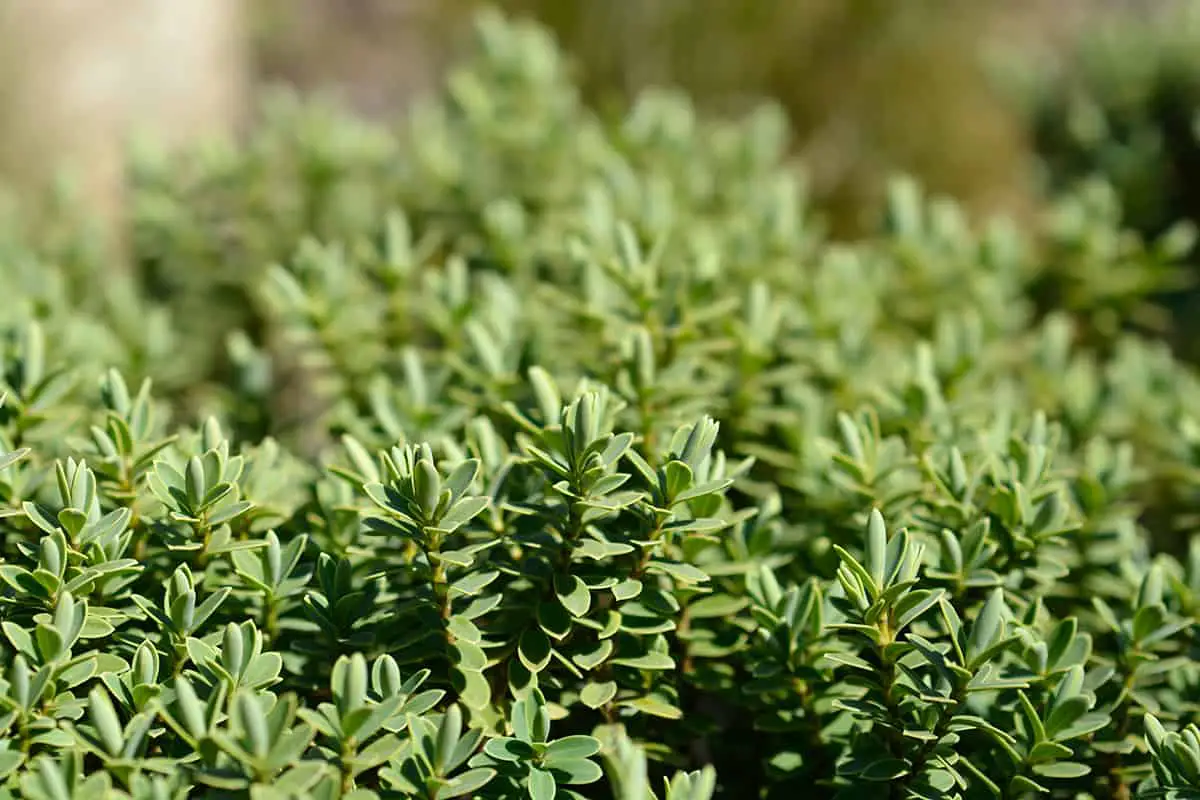
- Botanical name: Hebe rakaiensis
- Plant family: Plantaginaceae
- USDA hardiness zone:
- Mature height:
- Mature spread:
Also commonly known as the Rakai Hebe, this dwarf evergreen shrub is native to New Zealand. It produces dense, dome-shaped mounds of foliage, with tiny leaves standing on erect stems. Throughout summer, small white flowers emerge on spikes, adding extra interest.
This is an award-winning shrub that is easy to grow and requires no maintenance. It thrives in full sun but is not fussy about soil type, and does not need to be pruned. It is an excellent choice of a small shrub to grow in a container, and will also work well as a border. Shrubby Veronica can be planted in rows and trimmed to create a manicured low hedge.
Hydrangea ‘Fire Light Tidbit’
- Botanical name: Hydrangea paniculata ‘Fire Light Tidbit’
- Plant family: Hydrangeaceae
- USDA hardiness zone: 3- 8
- Mature height: 2 to 3 feet
- Mature spread: 2 to 3 feet
This is a dwarf variety of the Panicle Hydrangea, which is native to Russia, Japan, China, and Korea. It is an extremely compact shrub, which flowers in such abundance that the foliage can barely be seen when the plant is in full bloom. Flowers emerge in dense panicles, held up by stiff, thick stems.
They start out white in the middle of summer, developing to pink by fall, and can remain on the plant right into winter. This is a remarkably easy plant to grow which adds immense beauty to the landscape. It is ideal for growing in containers or in low borders, thriving in full sun and moist soils.
Common Juniper ‘Compressa’
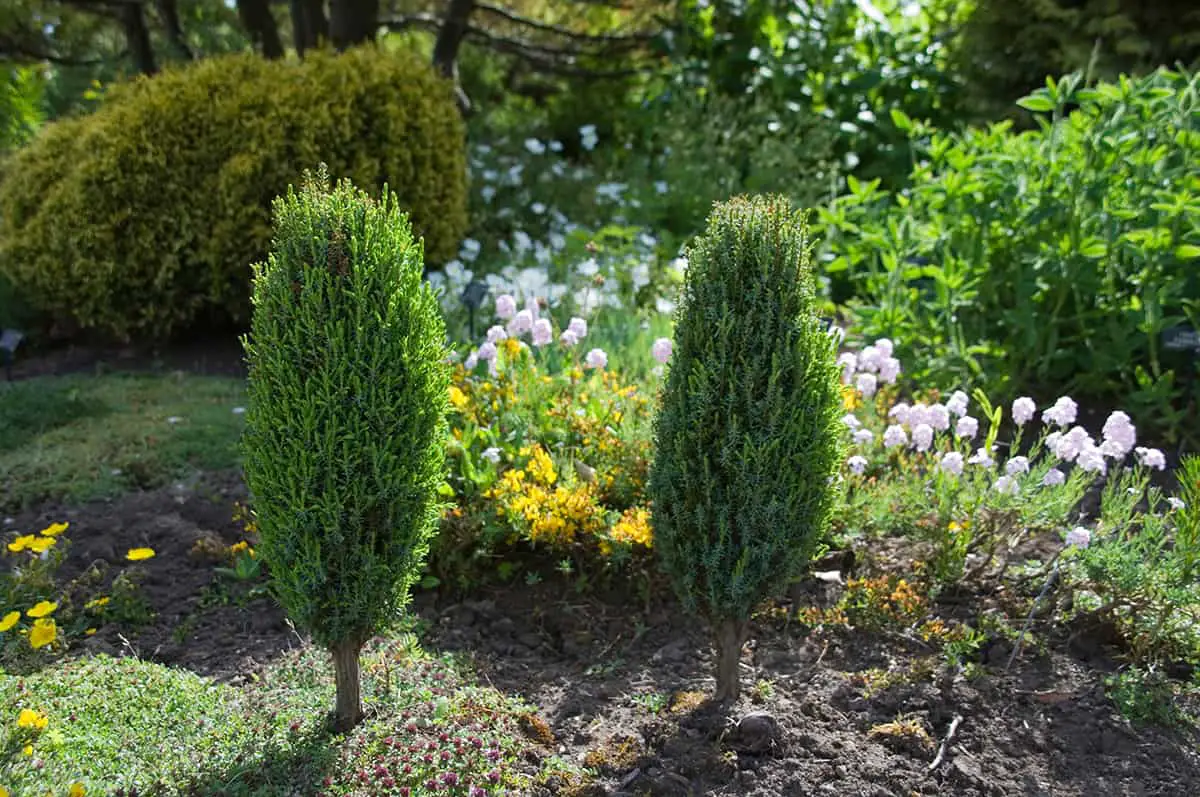
- Botanical name: Juniperus communis
- Plant family: Cupressaceae
- USDA hardiness zone: 2- 6
- Mature height: 2 to 3 feet
- Mature spread: 1 to 2 feet
This is a dwarf variety of the evergreen conifer, Common Juniper. It grows in a slender column shape which requires no pruning and makes for a well-manicured look in a garden without any maintenance at all.
The foliage is dense, taking the form of sharp blue-green needles which fade to a rust color in the fall. This is an exceptionally hardy plant, which is tolerant to drought and can grow in almost any type of soil. It thrives in full sun and will suffer when positioned in shade.
Creeping Juniper

- Botanical name: Juniperus horizontalis
- Plant family: Cupressaceae
- USDA hardiness zone: 3- 9
- Mature height: 6 inches to 2 feet
- Mature spread: 5 feet to 8 feet
This is an exquisite low-growing shrub that is native to much of Canada, and some of the northern United States. It has a horizontal growth habit, creating a lush carpet of foliage on branches held just a few inches above ground level.
This is an evergreen plant, producing scale-like foliage which is blue-green throughout most of the year but takes on a slightly lilac hue through winter. Creeping Juniper works well as ground cover but it can also look stunning cascading out of containers or over the edge of walls and rock gardens. It requires full sun and is drought tolerant once well established.
Arborvitae ‘Danica’
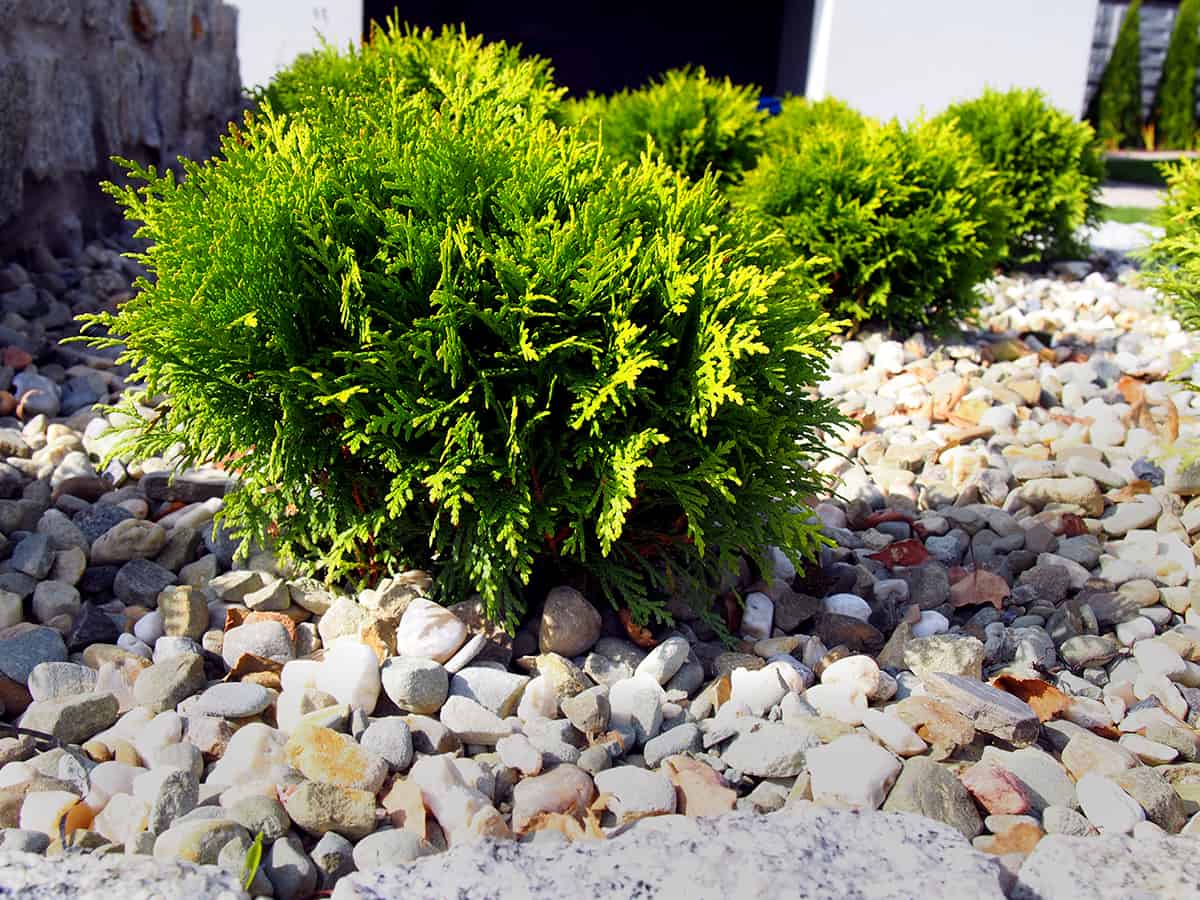
- Botanical name: Thuja occidentalis
- Plant family: Cupressaceae
- USDA hardiness zone: 2- 7
- Mature height: 1 to 2 feet
- Mature spread: 1 to 2 feet
This is a dwarf variety of Arborvitae, also known as Northern White Cedar. It is native to Canada and some of the northern US. This particular variety has achieved the Award of Garden Merit from the Royal Horticultural Society, due to its outstanding qualities. It grows in spherical mounds which appear to have been shaped into globes, but they require no pruning at all.
The evergreen foliage is a fresh shade of emerald green and grows in dense sprays. It grows slowly in most soil types and thrives in full sun. It is ideal for container planting, adding a fun and playful look to the landscape through every season.
Dwarf Mountain Pine ‘Ophir’
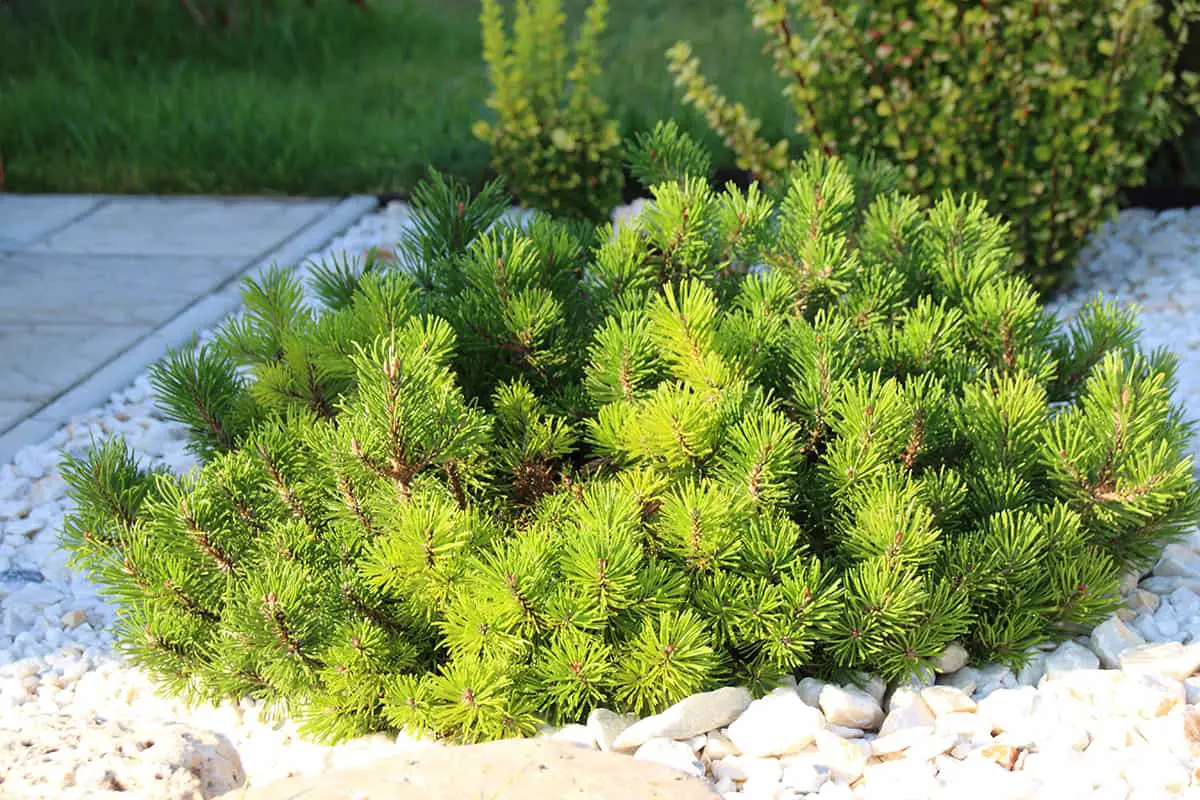
- Botanical name: Pinus mugo
- Plant family: Pinaceae
- USDA hardiness zone: 3- 7
- Mature height: 2 to 3 feet
- Mature spread: 2 to 3 feet
This dwarf evergreen conifer is also commonly known as Scrub Mountain Pine, Bog Pine, and Creeping Pine. It is native to Europe, producing a spherical mound of dense needle-like foliage throughout every season. The foliage of this plant has a striking color, which is a pale shade of yellow-green through summer, developing to lime green and then gold in winter.
This is a drought-tolerant plant that is perfect for growing in rock gardens or containers. It also works well in coastal locations since it is tolerant of salt. It thrives in full sun and is adaptable to most soil types. This is a slow-growing dwarf shrub that gains only 1 inch in size each year, so it is ideal for a low-maintenance garden.
Norway Spruce ‘Little Gem’
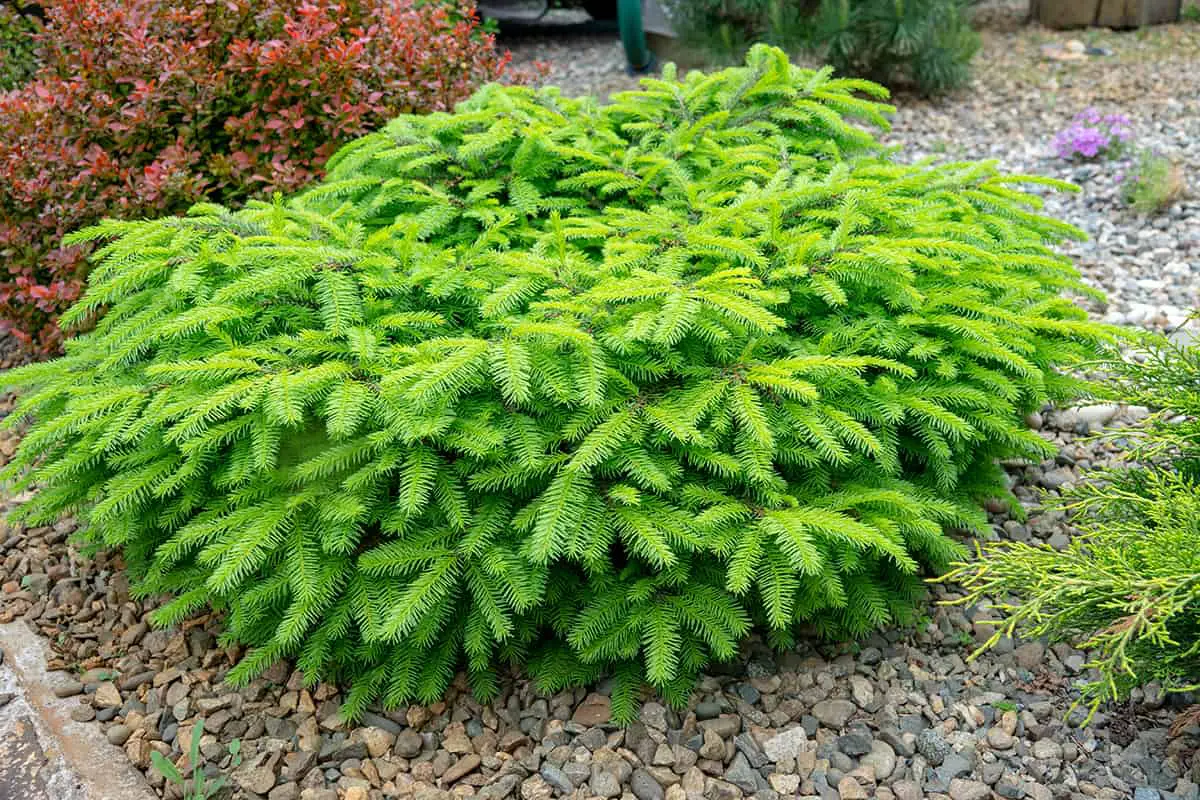
- Botanical name: Picea abies
- Plant family: Pinaceae
- USDA hardiness zone: 3- 8
- Mature height: Up to 1 foot
- Mature spread: 1 to 2 feet
This is a sought-after dwarf variety of Norway Spruce, which grows just 1 inch per year and reaches its eventual height of 1 foot over the course of a decade. It forms a globe shape, with dense branches covered in tiny, soft green needles. It will be a fresh green color in spring and darkens in winter to a deep forest green.
This shrub is tolerant of a range of soil types, including dry soils, but it prefers to be grown in moist conditions. It will struggle in warm climates, preferring cool temperatures and full sun. The ‘Little Gem’ was the recipient of the Award of Garden Merit from the Royal Horticultural Society, in recognition of its outstanding qualities.
